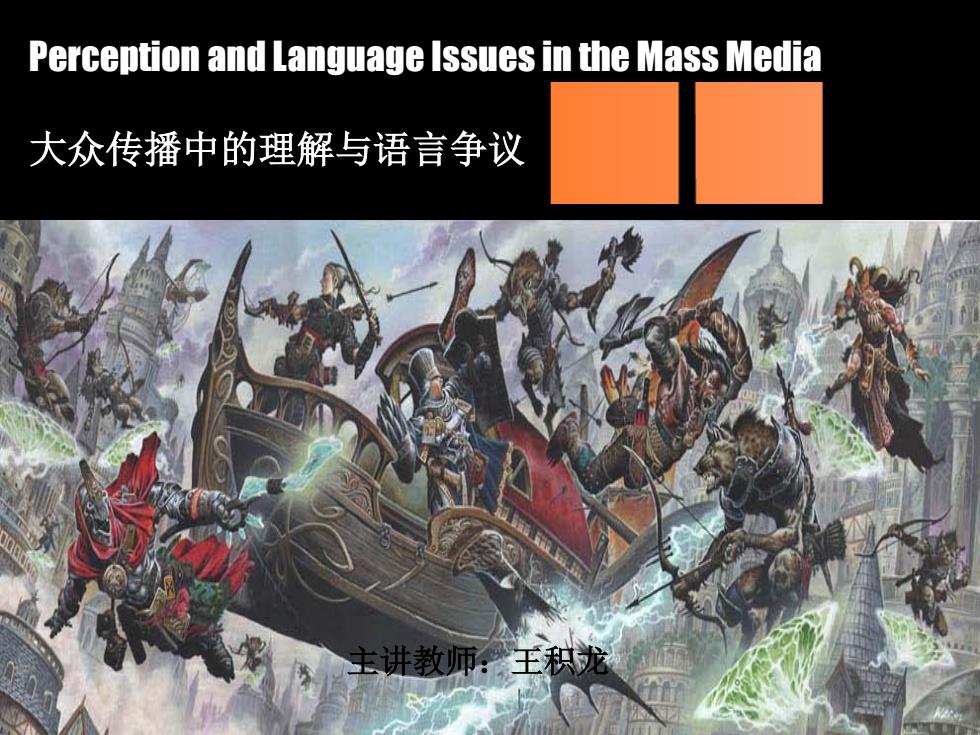
Perception and Language Issues in the Mass Media 大众传播中的理解与语言争议
Perception and Language Issues in the Mass Media 大众传播中的理解与语言争议 主讲教师:王积龙

Encoding Decoding ----Hall's Model ·霍尔的绵码与解码模式 Stuart Hall
Encoding & Decoding ----Hall’s Model • 霍尔的编码与解码模式

Encoding Contemporary semioticians refer to the creation and interpretation of texts as 'encoding'and 'decoding respectively.This unfortunately tends to make these processes sound too programmatic:the use of these terms is of course intended to emphasize the importance of the semiotic codes involved,and thus to highlight social A factors.For semioticians,there is no Audition Phonation such thing as an uncoded message, so that-for those who argue that all experience is coded-even 'encoding c=concept might be more accurately described s=sound-image as 'recoding'. Phonation Audition
Encoding • Contemporary semioticians refer to the creation and interpretation of texts as 'encoding' and 'decoding' respectively. This unfortunately tends to make these processes sound too programmatic: the use of these terms is of course intended to emphasize the importance of the semiotic codes involved, and thus to highlight social factors. For semioticians, there is no such thing as an uncoded message, so that - for those who argue that all experience is coded - even 'encoding' might be more accurately described as 'recoding'
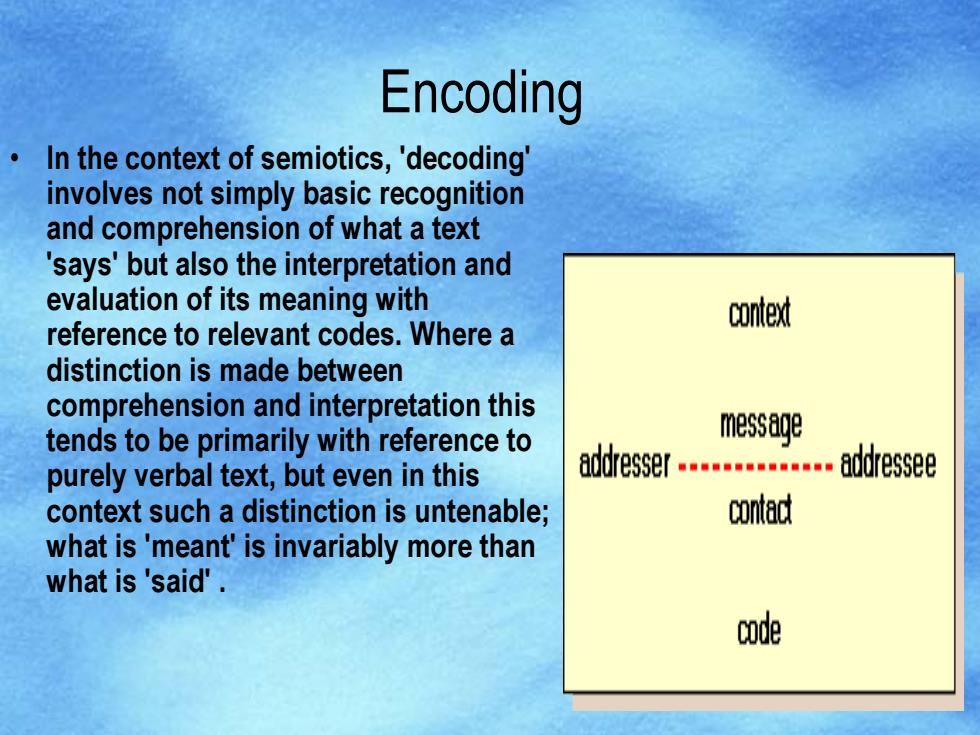
Encoding In the context of semiotics,'decoding involves not simply basic recognition and comprehension of what a text 'says'but also the interpretation and evaluation of its meaning with reference to relevant codes.Where a corted distinction is made between comprehension and interpretation this tends to be primarily with reference to message purely verbal text,but even in this addresser--addressee context such a distinction is untenable; contad what is 'meant'is invariably more than what is 'said'. code
Encoding • In the context of semiotics, 'decoding' involves not simply basic recognition and comprehension of what a text 'says' but also the interpretation and evaluation of its meaning with reference to relevant codes. Where a distinction is made between comprehension and interpretation this tends to be primarily with reference to purely verbal text, but even in this context such a distinction is untenable; what is 'meant' is invariably more than what is 'said'

Encoding Type Oriented Function towards Example referential context imparting information It's raining. expressive addresser expressing feelings or attitudes It's bloody pissing down again! conative addressee influencing behaviour Wait here till it stops raining! phatic contact establishing or maintaining social relationships Nasty weather again,isn't it? metalingual code referring to the nature of the This is the weather forecast. interaction(e.g.genre) poetic It droppeth as the gentle rain message foregrounding textual features from heaven
Encoding Type Oriented towards Function Example referential context imparting information It's raining. expressive addresser expressing feelings or attitudes It's bloody pissing down again! conative addressee influencing behaviour Wait here till it stops raining! phatic contact establishing or maintaining social relationships Nasty weather again, isn't it? metalingual code referring to the nature of the interaction (e.g. genre) This is the weather forecast. poetic message foregrounding textual features It droppeth as the gentle rain from heaven
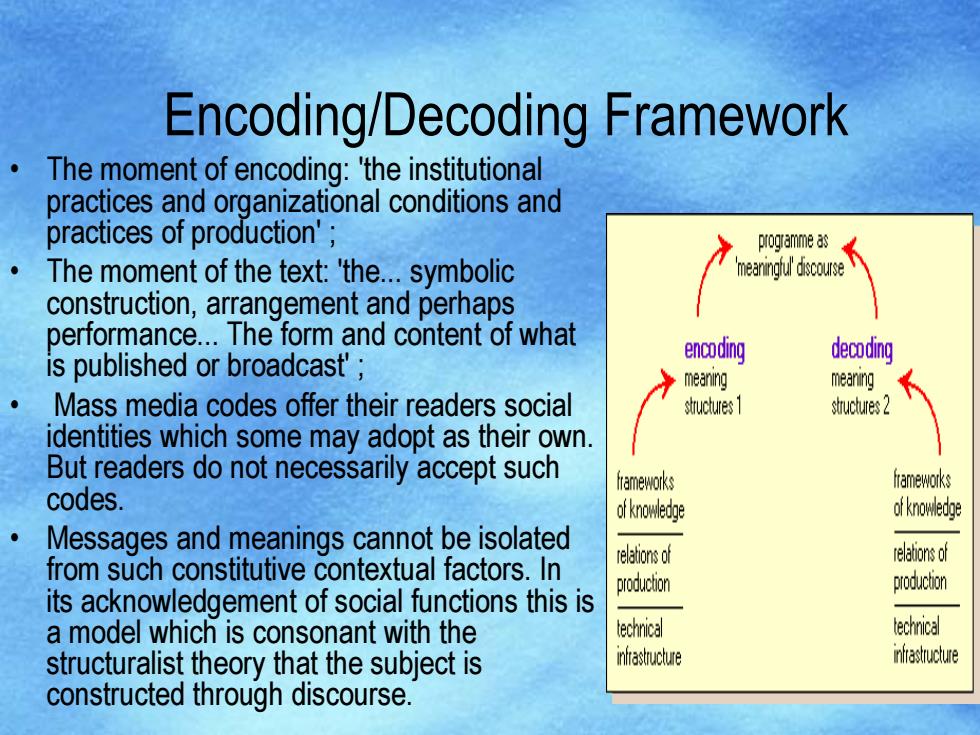
Encoding/Decoding Framework The moment of encoding:'the institutional practices and organizational conditions and practices of production'; programme as The moment of the text:'the...symbolic meaningfulise construction,arrangement and perhaps performance...The form and content of what is published or broadcast'; encoding decodng meaning meaning Mass media codes offer their readers social sructures1 structures2 identities which some may adopt as their own. But readers do not necessarily accept such frameworks frameworks codes. ofknowedge fknowlege Messages and meanings cannot be isolated from such constitutive contextual factors.In ieleioredt ref pioduction poduction its acknowledgement of social functions this is a model which is consonant with the techica technical structuralist theory that the subject is inrasrcre rhiauctue constructed through discourse
Encoding/Decoding Framework • The moment of encoding: 'the institutional practices and organizational conditions and practices of production' ; • The moment of the text: 'the... symbolic construction, arrangement and perhaps performance... The form and content of what is published or broadcast' ; • Mass media codes offer their readers social identities which some may adopt as their own. But readers do not necessarily accept such codes. • Messages and meanings cannot be isolated from such constitutive contextual factors. In its acknowledgement of social functions this is a model which is consonant with the structuralist theory that the subject is constructed through discourse

Encoding/Decoding Framework Dominant(or'hegemonic')reading:the reader fully shares the text's code and accepts and reproduces the preferred reading mme as (a reading which may not have been the result of any conscious discourse intention on the part of the author(s))-in such a stance the code seems 'natural'and 'transparent'; Negotiated reading:the reader partly shares the text's code and broadly accepts the preferred reading,but sometimes decoding resists and modifies it in a way which reflects their own meaning position,experiences and interests (local and personal sructures2 conditions may be seen as exceptions to the general rule)-this position involves contradictions; Oppositional ('counter-hegemonic')reading:the reader,whose social situation places them in a directly oppositional relation frameworks to the dominant code,understands the preferred reading but of knowledge does not share the text's code and rejects this reading,bringing to bear an alternative frame of reference(radical,feminist etc.) relationof (e.g.when watching a television broadcast produced on behalf of a political party they normally vote against). producion technical infrasructure
Encoding/Decoding Framework • Dominant (or 'hegemonic') reading: the reader fully shares the text's code and accepts and reproduces the preferred reading (a reading which may not have been the result of any conscious intention on the part of the author(s)) - in such a stance the code seems 'natural' and 'transparent'; • Negotiated reading: the reader partly shares the text's code and broadly accepts the preferred reading, but sometimes resists and modifies it in a way which reflects their own position, experiences and interests (local and personal conditions may be seen as exceptions to the general rule) - this position involves contradictions; • Oppositional ('counter-hegemonic') reading: the reader, whose social situation places them in a directly oppositional relation to the dominant code, understands the preferred reading but does not share the text's code and rejects this reading, bringing to bear an alternative frame of reference (radical, feminist etc.) (e.g. when watching a television broadcast produced on behalf of a political party they normally vote against)
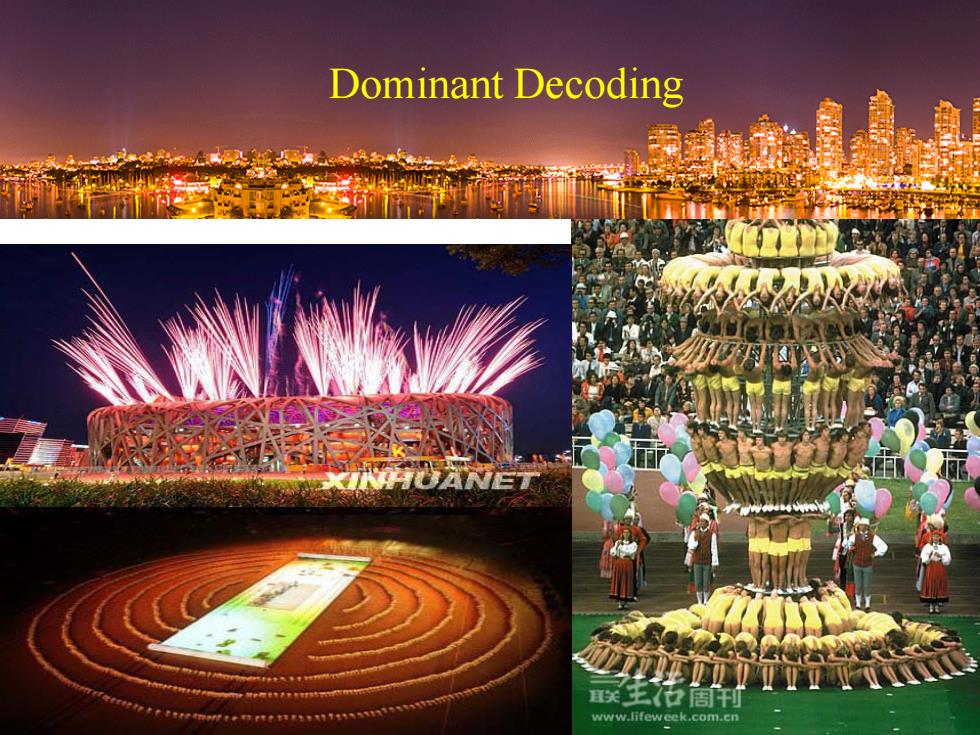
Dominant Decoding 2周 www.lifeweek.com.cn
Dominant Decoding

抗家救完美维少年” Nepotiated ec洗揭晓 Negotiated reading XINHUANET CCTV coMAL 当时我脑子片空白 y联得 CCTVcom
Negotiated Decoding Negotiated reading
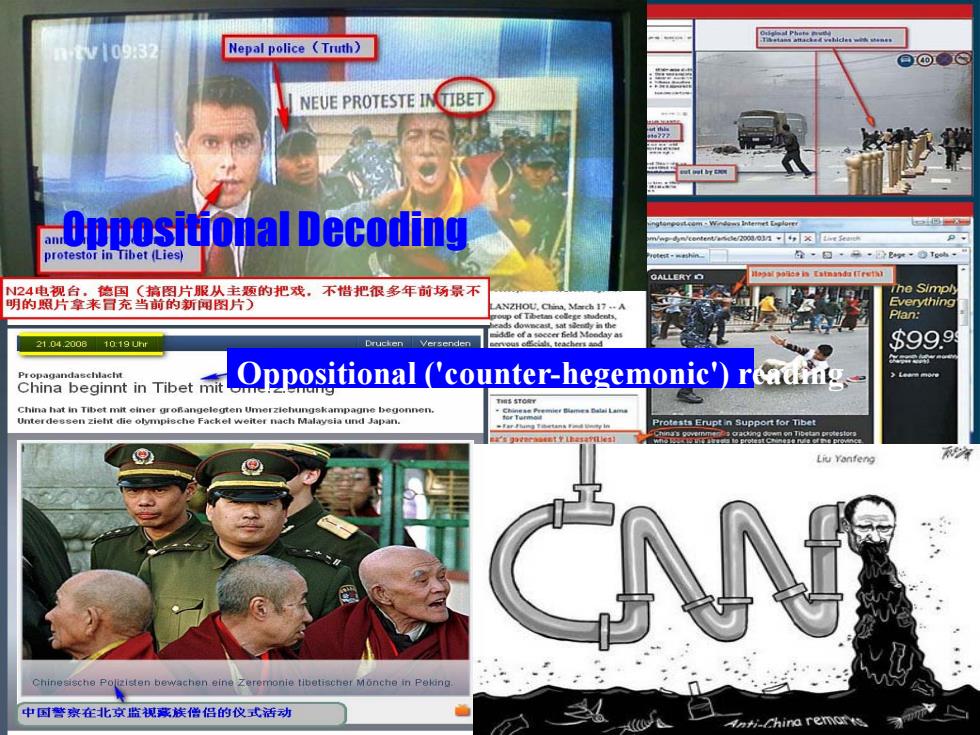
tv109:32 Nepal police (Truth) NEUE PROTESTE INTIBET .Oppositional Decoding protestor in Tibet(Lies) 硝的典:未警冕德翻价的把戏。不惜把很多年前场景不 3四 Everything Plan: 21020061a19Uh $99.9 Oppositional ('counter-hegemonic)reatg m Liu Yonfeng 中国警察在北京监视球族僧侣的仪式活动
Oppositional Decoding Oppositional ('counter-hegemonic') reading